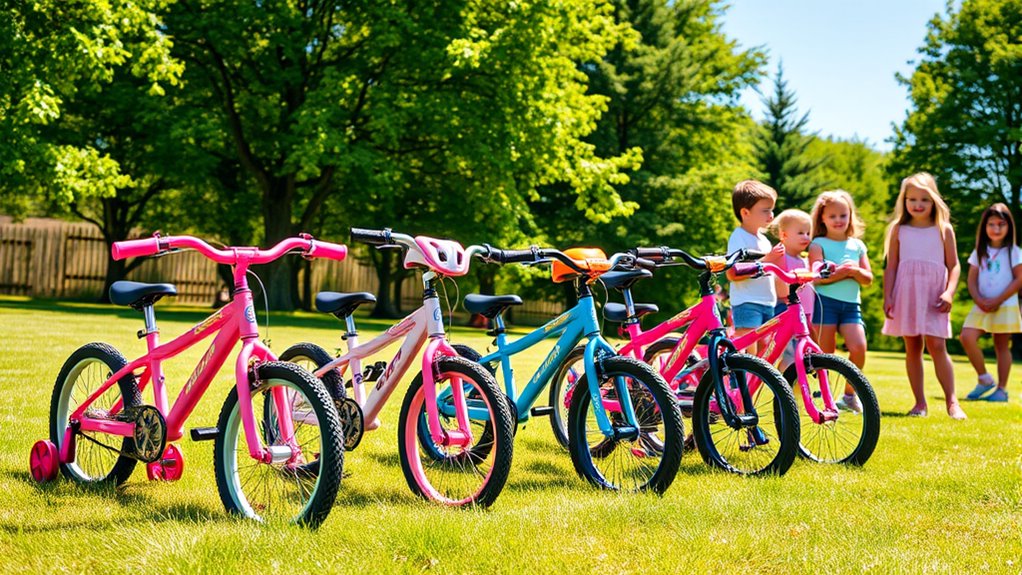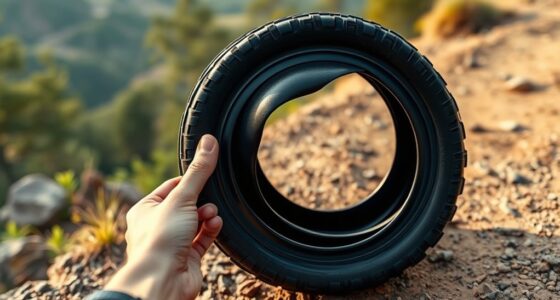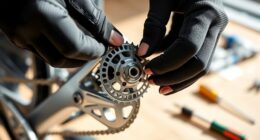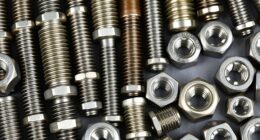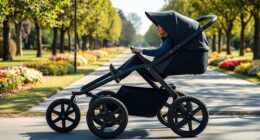To choose the right kids’ bike, start by measuring your child’s inseam to find a proper fit, ensuring they can reach the handlebars and pedals comfortably. Match the bike type to their age and skill level, such as balance bikes for beginners and geared bikes for more experienced riders. Select the appropriate wheel size—16-inch for younger kids or larger for older children—and check that the bike fits well with correct posture. Keep safety in mind, and learn more about testing and adjusting for ideal comfort and security.
Key Takeaways
- Measure the child’s inseam to select the bike size that fits comfortably and supports proper posture.
- Match bike type (balance or pedal bike with training wheels) to the child’s age and experience level.
- Choose wheel diameter based on the child’s height and skill, with smaller wheels for beginners and larger for experienced riders.
- Ensure the bike fits correctly, with proper reach to handlebars and pedals, and the helmet fits snugly and level.
- Regularly test brakes, tire pressure, and fit adjustments to maintain safety, comfort, and riding confidence.
Understanding Bike Frame Sizes and How to Measure Your Child
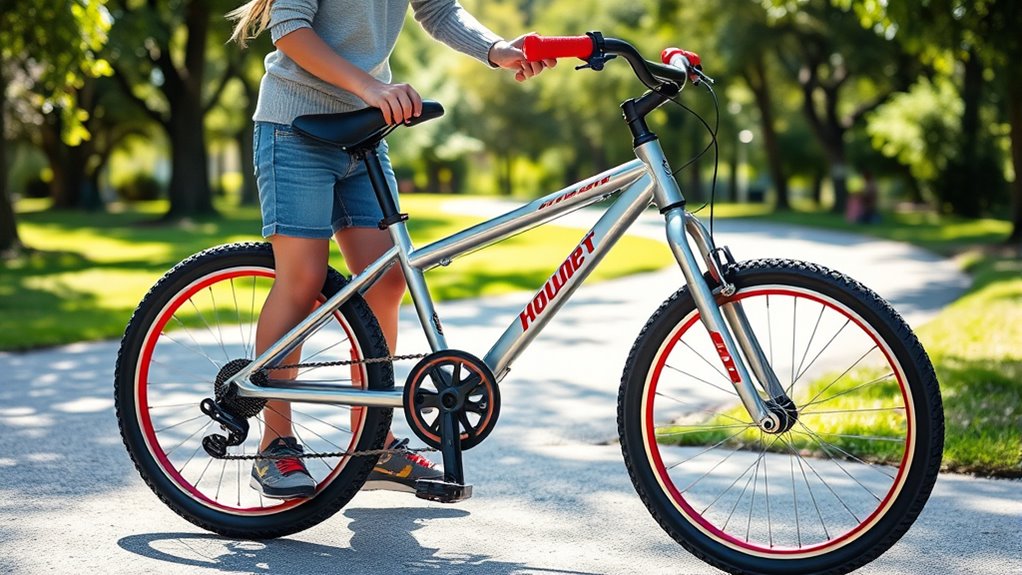
Choosing the right bike frame size for your child is essential to guarantee a comfortable and safe ride. To do this, start by measuring your child’s inseam—have them stand against a wall with their shoes on and measure from the floor to their crotch. This measurement helps determine the correct bike size. Ensuring the bike matches the child’s size and type makes for easier maintenance and a more enjoyable riding experience. Proper sizing makes bike maintenance easier, as a well-fitted bike reduces strain on parts and prolongs its lifespan. Additionally, proper sizing can prevent injuries caused by improper fit. Always ensure your child wears safety gear, like a helmet and pads, when riding. A correctly sized bike allows your child to reach the handlebars and pedals comfortably, increasing safety and confidence. Remember, a properly fitted bike isn’t just about comfort; it’s about keeping your kid safe on every ride. Being aware of bike frame sizes can help you select durable and safe bike components.
Matching Bike Types to Age and Riding Experience

Are you wondering how to select the right bike for your child’s age and riding skills? The key is to match the bike type with their experience level.
For beginners, a balance bike or a small pedal bike with training wheels provides stability and builds confidence. As they grow more skilled, you can upgrade to a bike with gears or a lightweight frame suited for their size.
Remember, bike helmet safety is essential—always ensure your child wears a properly fitted helmet.
Protective gear essentials, like knee and elbow pads, protect against falls and encourage safe riding habits.
Choosing the appropriate bike type not only makes riding more enjoyable but also fosters a lifelong love of cycling while keeping safety front and center.
Determining the Correct Wheel Diameter for Comfort and Control
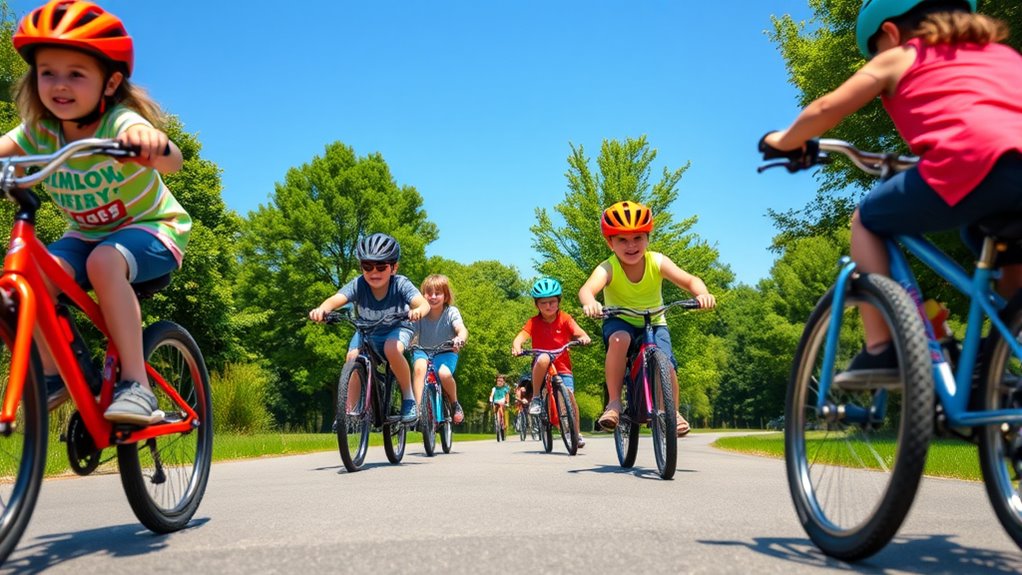
Selecting the right wheel diameter is vital for guaranteeing your child’s comfort and control while riding. Larger wheels, like 20-inch or 24-inch, provide smoother rides and better stability, especially on uneven surfaces. Smaller wheels, such as 16-inch, are more manageable for younger kids just learning to ride. When choosing, consider wheel materials—lightweight aluminum or durable steel—affecting weight and handling. Proper tire pressure is essential; inflated tires improve comfort, grip, and control, while under-inflated tires can cause sluggishness or accidents. Keep the tire pressure at the recommended level for your child’s weight and riding style. Additionally, selecting the appropriate bike size based on your child’s height and skill level can significantly impact their riding experience. Being aware of gumball machine locations and maintenance practices can also be useful for families planning outings to public spaces with children. Understanding how performance tuning principles might relate to bike adjustments can help optimize ride quality for young cyclists. Regularly checking tire condition ensures safety and prolongs the lifespan of the bike.
Signs That Indicate a Bike Is the Right Fit for Your Child
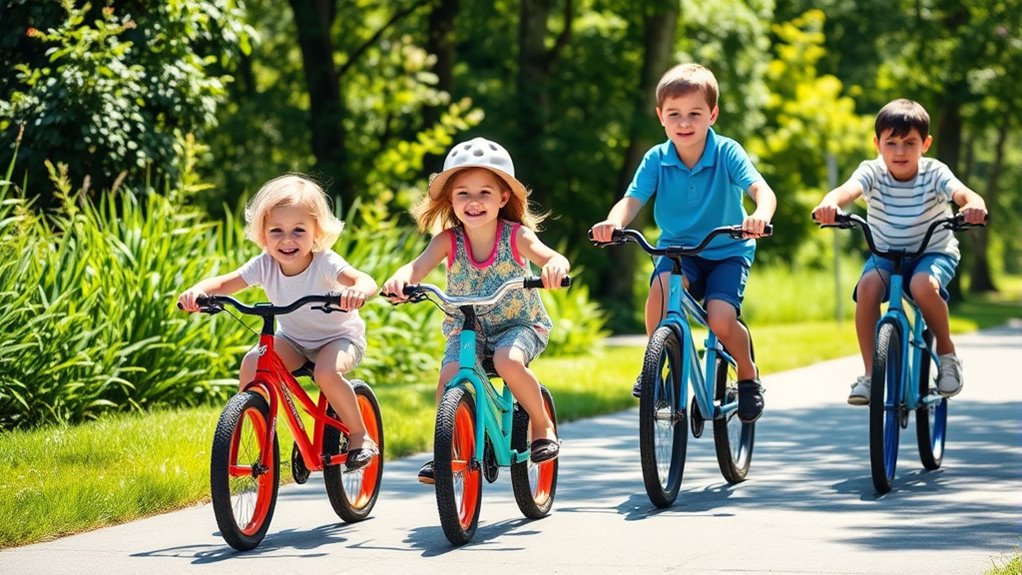
When your child’s bike fits properly, they’ll feel more confident and comfortable while riding. A good fit means their bike allows for proper riding posture, with their back straight and elbows slightly bent. Check that the bike helmet fits snugly without being too tight—it should sit level on their head, covering the forehead comfortably. Their knees should bend slightly when the pedal is at the bottom, and they shouldn’t have to stretch or hunch forward. If your child can easily reach the handlebars and pedals without overextending, it’s a good sign the bike is right for them. Comfort and safety are key indicators that the bike is the right fit, helping them enjoy riding while reducing the risk of falls or discomfort. Proper bike sizing can also promote better bike safety and comfort, ensuring a smoother and more enjoyable riding experience. Additionally, ensuring the bike has the correct bike size can prevent long-term postural issues and enhance overall riding enjoyment. Regularly checking the proper fit as your child grows ensures their bike remains safe and comfortable over time, especially since angel number soulmate guidance may encourage new beginnings in their confidence and independence.
Tips for Testing and Adjusting the Bike for Optimal Safety and Performance

To guarantee your child’s bike provides a safe and comfortable riding experience, it’s important to test and adjust it properly before each ride.
Start by checking the helmet fit—make sure the helmet sits snugly without being too tight, covering the forehead and not shifting easily.
Start by ensuring the helmet fits snugly, covering the forehead without being too tight.
Next, test the brake responsiveness by squeezing both brakes firmly; they should engage smoothly and stop the bike effectively without excessive force.
Adjust the brake pads if necessary, ensuring they contact the rim evenly.
Inspect the tire pressure and make sure the seat and handlebars are securely tightened and at the correct height.
These simple checks help prevent accidents, improve control, and make riding more enjoyable for your child.
Regular adjustments keep safety and performance exceptional.
Additionally, consulting professional bike fitting resources can help ensure your child’s bike is perfectly tailored for their size and riding style, which can also contribute to better riding comfort and safety.
Proper bike maintenance routines, including regular inspections, can further extend the lifespan of the bike and enhance safety during rides.
Furthermore, understanding mechanic shops for fuel injection cleaning can inform how to find quality service providers for bike maintenance and repairs. Engaging with leadership skills in the bicycle community—such as workshops or clubs—can also promote safety awareness and skill development for young riders.
Frequently Asked Questions
How Often Should I Replace My Child’S Bike as They Grow?
You should replace your child’s bike based on their growth cycle recommendations and bike size calibration.
As they grow, check if the bike still fits comfortably—if they’re outgrowing it or it no longer supports proper riding posture, it’s time for an upgrade.
Typically, reassess every six months to a year, or sooner if they’ve had a growth spurt.
Keeping the bike age-appropriate guarantees safety and helps build confidence.
Are There Specific Safety Gear Recommendations for Different Bike Types?
Like a trusty shield, safety gear keeps your child protected. For all bike types, guarantee the helmet fit is snug but comfortable, not too tight or loose.
Knee pads are essential to protect against scrapes, especially on rough terrains.
Consider additional gear like elbow pads for mountain biking or reflective gear for visibility.
Proper safety equipment adapts to the bike type, keeping your child safe no matter the ride.
How Can I Teach My Child Proper Bike Maintenance?
To teach your child proper bike maintenance, start with simple tasks like bike cleaning to keep their bike in good condition.
Show them how to check and adjust gears for smooth shifting, and explain why gear adjustment matters.
Encourage them to regularly inspect brakes and tires for safety.
Make maintenance fun and routine, so they develop good habits early, ensuring their bike stays reliable and safe for every ride.
What Are the Best Storage Practices for Kids’ Bikes?
Think of storing your child’s bike like guarding treasure. Use sturdy bike lock strategies to secure it, especially outdoors. Opt for a storage container that shields it from the elements.
If space allows, hang the bike vertically or lean it against a wall in a dry spot. Regularly clean and check the tires and chain to keep it in top shape. Proper storage extends your bike’s life and keeps it safe.
How Do Weather Conditions Affect Bike Safety and Maintenance?
Weather conditions impact bike safety and maintenance considerably. Rain gear helps keep you dry, but wet surfaces reduce tire traction, making slips more likely.
After riding in rain, clean and dry your bike to prevent rust and guarantee proper function.
Check brakes and tires regularly, especially in wet weather, to maintain safety.
Adjust riding speed and be extra cautious on slippery roads to avoid accidents.
Conclusion
Choosing the right bike size and type guarantees your child’s safety and enjoyment. Did you know that properly fitted bikes can reduce accidents by up to 45%? By understanding frame sizes, matching bikes to their age, and testing for comfort, you set your kid up for confident riding. Keep an eye on signs they’re ready for adjustments, and they’ll enjoy every ride while staying safe. Your attention to detail makes all the difference!
